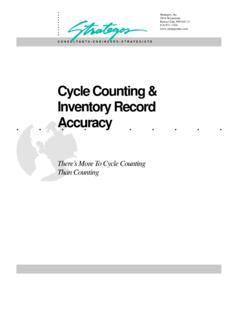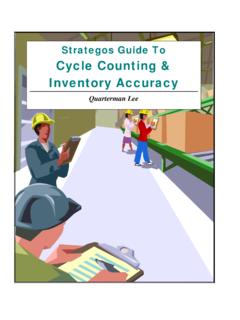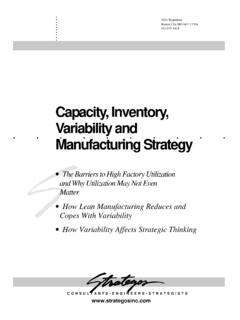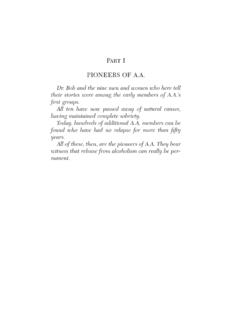Transcription of Pioneers of Lean Manufacturing— Taiichi Ohno
1 , Inc. Pioneers of Lean Manufacturing Taiichi ohno & Shigeo Shingo Featuring an Interview With Norman Bodek 3916 Wyandotte Kansas City MO 64111 USA 816-931-1414 2 Pioneers of Lean Manufacturing Taiichi ohno & Shigeo Shingo Featuring an Interview With Norman Bodek, Author of Kaikaku: The Magic and Power of Lean Introduction Norman Bodek is an author and publisher who was among the first to bring Japanese management techniques to the West. His new book, Kaikaku, weaves together his own story and fascinating profiles of key personalities such as ohno and Shingo along with the principles of Lean. In the following interview, Norman gives us insight to these topics and a preview of his book. The Essence of Lean Manufacturing Strategos: What is your overall view of Lean Manufacturing and the Toyota Production System?
2 Bodek: Lean is an unending journey to be the most innovative, most effective and efficient organization. The Power and Magic of Lean is to continually discover the hidden opportunities existing all around you. There will always be wastes to be eliminated. It seems to grow just like dust on your furniture. And always remember that people have unlimited creative ability but they must be challenged, encouraged, respected and expected to change. Continuous improvement must become your way of life. Hiroshi Okuda, CEO and chairman, Toyota Motors has said: I want everyone at Toyota to change or at least do not be an obstacle for someone else wanting to change. I also want everyone to write down their change plans for the year. 3 Strategos: What do you think is the essence of Toyota Production System as opposed to superficial aspects?
3 Bodek: Simply focus on the elimination of all non-manufacturing wastes: inventory, wasted motion, transportation, quality defects, change-overs, and the biggest waste- underutilization of people's talents and creative ability. Strategos: What does it really take to make it work well? Bodek: Read my book Kaikaku The Power and Magic of Lean and listen to Dr. Shingo's advice an, "Do it!" Lean is not complicated: you determine you want to be the best, you gather everyone into improvement teams, you relentlessly improve every single day, and overcome your resistance to change. Strategos: Who really developed the Toyota Production System? Bodek: I once asked Dr. Shigeo Shingo, Who really discovered Lean, you or Taiichi ohno ? Shingo looked at me and quickly said, I did, for I was ohno s teacher.
4 At a later time I asked an ex-Toyota group manager, Chihiro Nakao, who worked with both Shingo and ohno a similar question, Who really discovered Lean, Shingo or ohno ? His answer was, Which came first the chicken or the egg? Of course, both Dr. Shingo and Mr. ohno both played significant roles and it was through their conceptual genius that Lean was born. Strategos: What were the key personality characteristics that Shingo and ohno brought together that provided so much success? Bodek: They were both like tigers, fiercely aggressive, neither would accept the idea that something could not be done. They gave you the concept and told you to do it. ohno would simply say, "I want you to change this warehouse into a machine shop and I want everyone working there to be retrained.
5 I will come back in one year to see it done." He did not tell them how to do it. ohno had the power, as chairman of Toyota Gosei at the time, and was ruthless." You had very little choice with him. Dr. Shingo was also a tiger, but a gentle tiger. He was absolutely brilliant, probably the greatest manufacturing genius of our time, able to solve every manufacturing problem presented to him. His way was different. He was a teacher. He would help you by asking you questions and encouraging you to experiment. He knew you had the answers within you. He would teach you about waste and give you guidance on how to eliminate that waste. Strategos: How did ohno and Shingo arrive at this particular set of elements for their system? Bodek: ohno said he learned from three people: Mr.
6 Toyoda who had visited America earlier, Dr. Shingo who was Toyota's primary consultant and teacher, and Henry Ford. Ford was able to build a car in 4 days from iron ore coming out of the ground to the finished product. ohno then went and found a copy of Henry Ford's book "Today and Tomorrow," and said, "If Ford can do it so can we." Dr. Shingo was an industrial engineer who studied carefully Frederick Taylor and Frank Gilbreth learning about time and motion studies. His big breakthrough was to realize the difference between process and operations, process being the total flow of manufacturing from the customer's order to the finished product and 4operations, a series of machines. By focusing on process he was able to teach us how to smooth out our operations to be more efficient.
7 Taiichi ohno Strategos: What was ohno like? Bodek: Well, ohno had a reputation of creating fear in others. He was often called ruthless in his desire to drive out waste from the Toyota system. One day ohno walked into one of the large warehouses at Toyota Gosei and said to the staff of managers around him, Get rid of this warehouse and in one year I will come back and look! I want to see this warehouse made into a machine shop and I want to see everyone trained as machinists. And sure enough, one year later that building became a machine shop and everyone had been retrained. ohno did not tell then how to do it. He just demanded that they do it. ohno knew the economic benefits to Lean, knew it wasn t easy to bring change, and was forceful in bringing it forward.
8 Another time I was standing inside a factory near Tokyo, in front of a newly purchased automated delivery system. The system allowed an operator to pick out the necessary parts to be delivered to the assembly line. It was impressive to see the operator and her proficiency using the automated system fulfilling orders. A former assistant to Mr. ohno was standing with a group of the company s managers and he said to me, Norman, what would ohno have said about this automated warehouse? I said, without thinking, ohno would have said, Get rid of it. All the managers looked shocked. I am sure their minds were buzzing, How can we get rid of it? Strategos: ohno seems was demanding, arbitrary and difficult. Yet, employee participation is a major source of Toyota's strength.
9 How do you explain the apparent paradox? Bodek: From what I was told, ohno was both ruthless and relentless. Toyota needed that kind of energy to go from producing junky cars in 1960 to world's richest automotive company. Toyota was rough on all employees and on all of their suppliers but an employee has never been laid off (no downsizing), a supplier has never gone bankrupt (in fact, each supplier is a leader in their field), and Toyota is able to open new plants in America while we do to China. Toyota also invests in their employees. They want each one to learn and grow. Taiichi ohno Carrer Highlights Taiichi ohno was born in Manchuria, China in 1912 and graduated from Nagoya Technical High School. He joined Toyota in 1932 and for about twenty years worked his way up in the firm.
10 In the 1940's and early 1950's, ohno was the assembly manager for Toyota and developed many improvements that eventually became the Toyota Production System. Toyota was verging on bankruptcy during much of this period and could not afford major investments in new equipment or massive inventories. The 1950's also saw the beginning of a long collaboration with Shigeo Shingo and the refinement of their earlier efforts into an integrated Manufacturing Strategy. 5 ohno 's career accelerated as a result of his success as Assembly Shop Manager and he became an executive Vice President in 1975. In the early 1980's, ohno retired from Toyota and was president of Toyota Gosei, a Toyota subsidiary and supplier. Taiicho ohno died in Toyota City in 1990. Shigeo Shingo Strategos: What about Dr.








